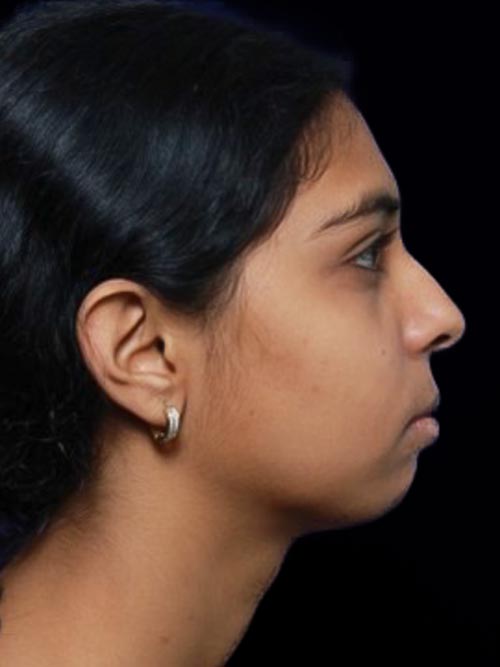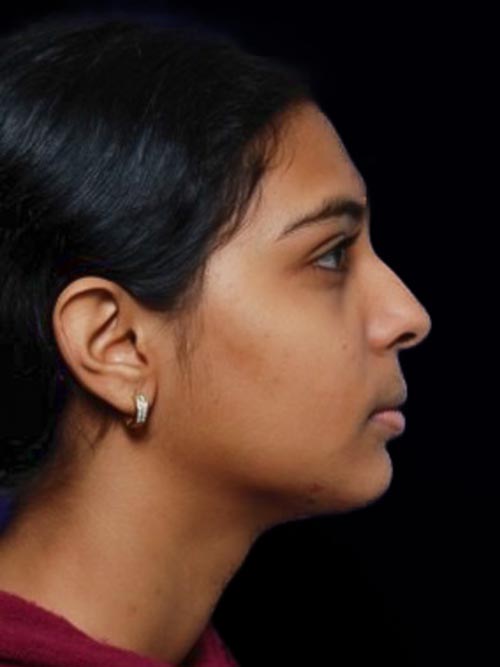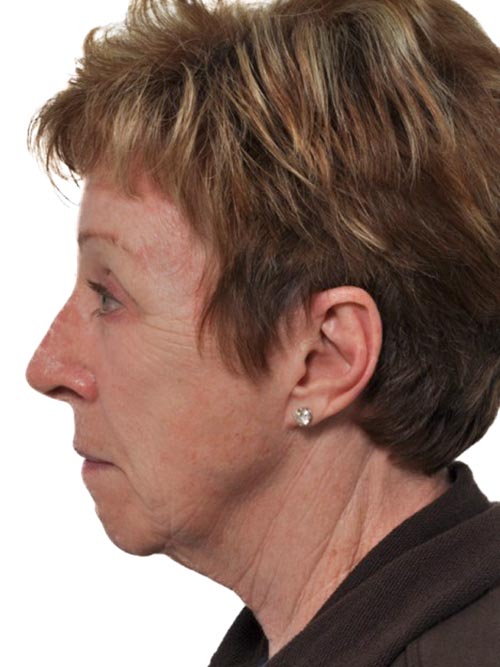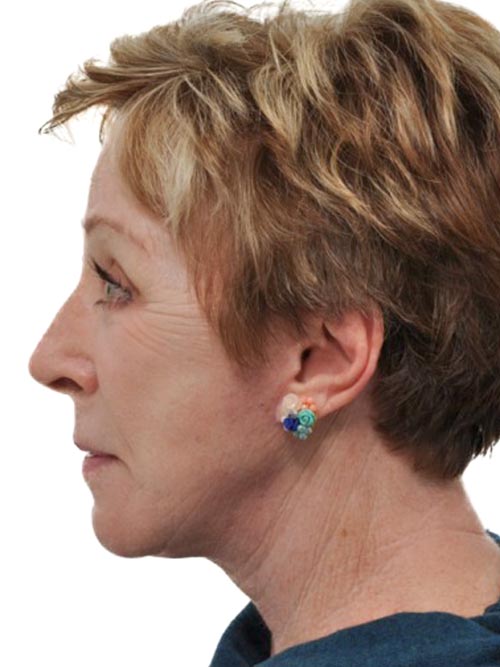Chin Implants
Chin implants may be used to permanently correct inadequate chin projection, creating more distance between the chin and the neck. The chin implant procedure may be performed as a stand-alone procedure or in conjunction with a face lift, a neck lift, or a rhinoplasty. You also have the option of placing implants that add lateral width for a stronger jaw, a popular procedure among men.
The Chin Implant Procedure
Dr. Yellin will determine the optimum implant for you, guided by your facial aesthetic desires, during your consultation prior to surgery. The procedure is performed under either local or general anesthesia depending on the clinical circumstance. An incision is made under the chin. The implant is placed into the surgically created pocket and secured. The incisions are then closed, completing the procedure. The final scar is well hidden in a natural crease under the chin.
Before & After Photos
*All photos shown are patients of Dr. Yellin and are the property of Marietta Facial Plastic Surgery, Laser & Aesthetics Center. Individual results may vary. Please see full disclaimer.






All photographs and other material presented on this website are the property of Dr. Yellin. Please do not download or reproduce the images without the express written consent of Dr. Yellin.
Disclaimer: Individual results may vary. No guarantee of results, stated or implied by any photo or statement on this website can be made. Please see full disclaimer.
Dedicated Care for Your Chin Implant Experience
At Marietta Facial Plastic Surgery, Laser & Aesthetics Center, we are committed to providing dedicated care throughout your chin implant journey. From your initial consultation to the final follow-up appointment, our experienced team ensures that you feel supported, informed, and confident every step of the way. We take the time to understand your unique facial structure and aesthetic goals, allowing us to customize your treatment plan for optimal harmony and balance. Utilizing the latest techniques and high-quality materials, we achieve natural-looking, enduring results that enhance your profile and overall appearance. Our compassionate approach to patient care ensures a comfortable recovery, so you can enjoy your enhanced features with peace of mind. Trust Marietta Facial Plastic Surgery, Laser & Aesthetics Center to help you achieve the defined, proportionate chin you desire with precision and personalized attention.
Atlanta & Marietta Chin Implant Surgeons
Based in Atlanta, Marietta Facial Plastic Surgery, Laser & Aesthetics Center has been a leading provider of chin implants since 1996. We proudly serve patients throughout Atlanta, Marietta, Acworth, Woodstock, and the rest of the country. To schedule your consultation or to request more information, please fill out the form below or call us at (770) 425-7575.
FAQs
What facial concerns can chin implants improve?
Chin implants enhance a recessed or under-projected chin, bringing it forward to align with the nose and lips. By giving the lower face clearer definition, an implant can sharpen the jawline, reduce the appearance of a double chin created by weak projection, and create a more proportionate side profile so attention is shared evenly among all facial features.
How does chin projection influence facial harmony?
A well-positioned chin balances the mid-face and brow, anchoring the vertical line drawn down from the lips. When the chin sits too far back, the nose can look larger and the neck less defined. Even modest forward enhancement can recalibrate these proportions, making the profile appear straighter and the jaw–neck junction crisper without altering other structures.
Who is an ideal candidate for a chin implant?
Candidates typically feel their chin appears small, receded, or lacks definition despite normal weight and healthy skin tone. Good overall health, stable dental alignment, and realistic expectations are important. A consultation evaluates bone structure, bite position, and soft-tissue thickness to confirm that adding projection—as opposed to jaw surgery or soft-tissue contouring—will best achieve the desired change.
What materials are commonly used for chin implants?
Medical-grade silicone and porous polyethylene are frequent choices. Silicone is smooth and can be molded precisely, while porous implants allow limited tissue ingrowth for subtle stabilization. Both materials are inert, meaning the body tolerates them well. Selection depends on desired firmness, implant size range, and surgeon preference based on long-term familiarity with each option.
How does chin augmentation differ from jawline surgery?
A chin implant adds targeted volume to the central point of the lower face without altering bone relationships. Jaw surgery (orthognathic surgery) repositions entire segments of the mandible for functional bite correction. For many people satisfied with their dental occlusion, an implant supplies cosmetic projection without the complexity or orthodontic requirements of skeletal movement.
Can a chin implant reduce the look of a prominent nose?
Yes. A stronger chin can balance a dominant nasal profile, making the nose appear more proportionate from the side. By adjusting only the chin, many patients achieve harmony without altering nasal bone or cartilage. Surgeons analyze profile photographs to demonstrate how subtle chin advancement changes the relative scale of other features.
Are chin implants suitable for both women and men?
Absolutely. While men may favor a broader, squarer implant to emphasize strength, women often prefer a gentle projection that refines the jaw without adding excessive width. Implants come in varied shapes and sizes; customizing contour and position respects gender identity and individual taste, ensuring enhancement looks authentic rather than standardized.
How is symmetry addressed when placing a chin implant?
Small natural asymmetries in bone or soft tissue are common. During surgery, the implant can be rotated or trimmed to offset these differences, and the soft-tissue envelope is carefully centered so the chin arises evenly beneath the lower lip. The goal is balanced visual alignment, not absolute mirror-image perfection, which rarely exists in natural faces.
Will a chin implant change how I speak or chew?
An appropriately sized chin implant sits on the bone’s surface, away from tongue, teeth, and jaw-joint mechanics. Speech patterns and bite function therefore remain the same once tissues settle. Early swelling can feel unfamiliar, but natural movement returns as the soft tissues adapt around the new contour.
How do chin implant shapes vary?
Implants may be anatomic—with tapered wings hugging the mandible—or more central “button” styles for localized projection. Some designs add subtle vertical length, while others focus solely on forward prominence. Choice depends on goals such as elongating a short lower face versus sharpening the point without widening. Surgeons display samples or 3-D previews to illustrate these nuances.
Can chin implants help define the neck?
By pushing the soft-tissue curtain forward, a stronger chin creates a clearer break between jaw and upper neck. This enhanced cervicomental angle can make the neck appear longer and slimmer, even if no fat is removed. When fullness beneath the chin is minimal, projection alone can yield a striking profile refinement.
What role does soft-tissue thickness play in planning?
Thick submental tissue may obscure modest implant shapes, while very thin skin can telegraph sharp edges. Surgeons measure pinch thickness and adjust implant size or contour to ensure the added projection looks smooth. Occasionally, combining subtle soft-tissue trimming or fat grafting fine-tunes the envelope so the implant reads naturally.
How durable are chin implants?
Because implant materials are biologically inert and placed directly on bone, they are designed to be lifelong devices. The surrounding bone may even form a shallow pocket that cradles the contour. Removal is rarely requested unless personal aesthetic preferences change significantly over time.
Will facial hair conceal or reveal a chin implant?
Beards can camouflage a weak chin, but growth pattern limitations often leave projection short of desired strength. After augmentation, some men notice styling flexibility—able to trim shorter without losing definition. The implant hides beneath muscle and skin, so surface hair density does not influence visibility once swelling resolves.
How does aging affect chin implant appearance?
Bone remains stable throughout adulthood, so the implant’s position stays constant. Natural soft-tissue descent may soften definition over decades, but the added skeletal framework continues to support the lower face. Good skincare, sun protection, and healthy weight maintenance help preserve clarity around the jawline as surrounding tissues mature.
Are nonsurgical fillers a viable alternative to chin implants?
Injectable fillers can trial added projection and are useful for subtle enhancements or asymmetry correction. However, fillers are temporary and add soft volume rather than firm structure. For those seeking pronounced or lasting change, a solid implant typically offers more stable support and doesn’t require periodic maintenance treatments.
How is chin implant size determined?
Preoperative analysis involves profile photography, caliper measurements, and sometimes digital imaging. Surgeons assess how far the lower lip or nose projects relative to the chin and select an implant that brings the bony point into balanced alignment. Several sizes are kept available so adjustments can be made intra-operatively for optimal harmony.
Does a chin implant affect dental work or braces?
Because the implant sits outside the bony cortex, it does not interact with tooth roots or orthodontic hardware. Routine dental cleanings, braces, or aligners proceed as usual once healing is complete. Patients simply inform dental professionals about the implant so instrumentation around the mental region is handled gently.
How do surgeons minimize visible scarring?
Incisions are commonly placed inside the lower lip or in a small crease beneath the chin, both hidden from direct view. Meticulous closure with fine sutures, combined with prudent scar care and sun avoidance, helps any external line fade into skin texture, leaving the new contour as the focal point rather than the incision.
What misconceptions exist about chin implants?
Some worry implants look artificial or overly large, yet modern sizing favors subtle balance over exaggerated projection. Others fear sensation loss; while mild numbness can occur initially, nerves typically adapt. Many people also think only models or actors pursue chin augmentation, but the procedure simply addresses common proportion issues, benefiting anyone who feels their profile lacks definition.
